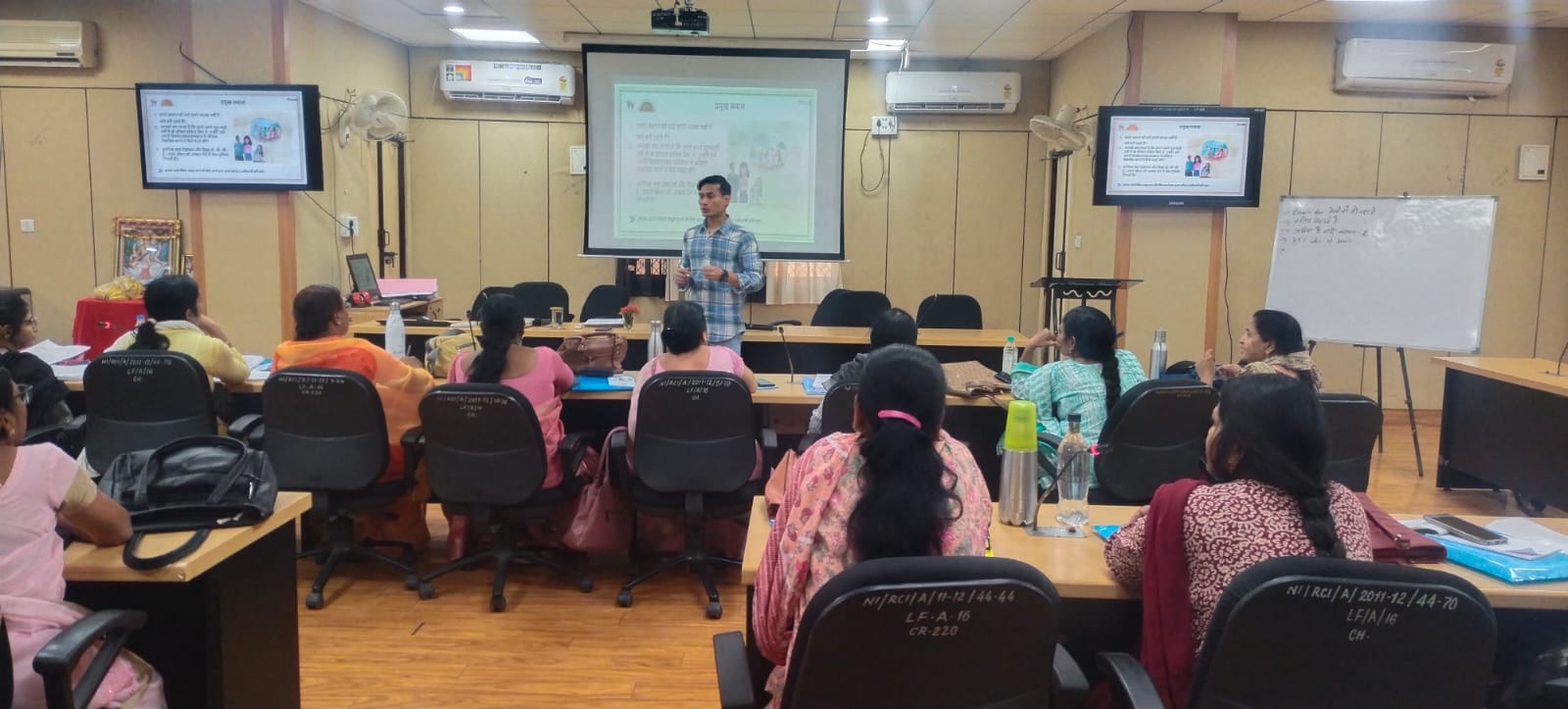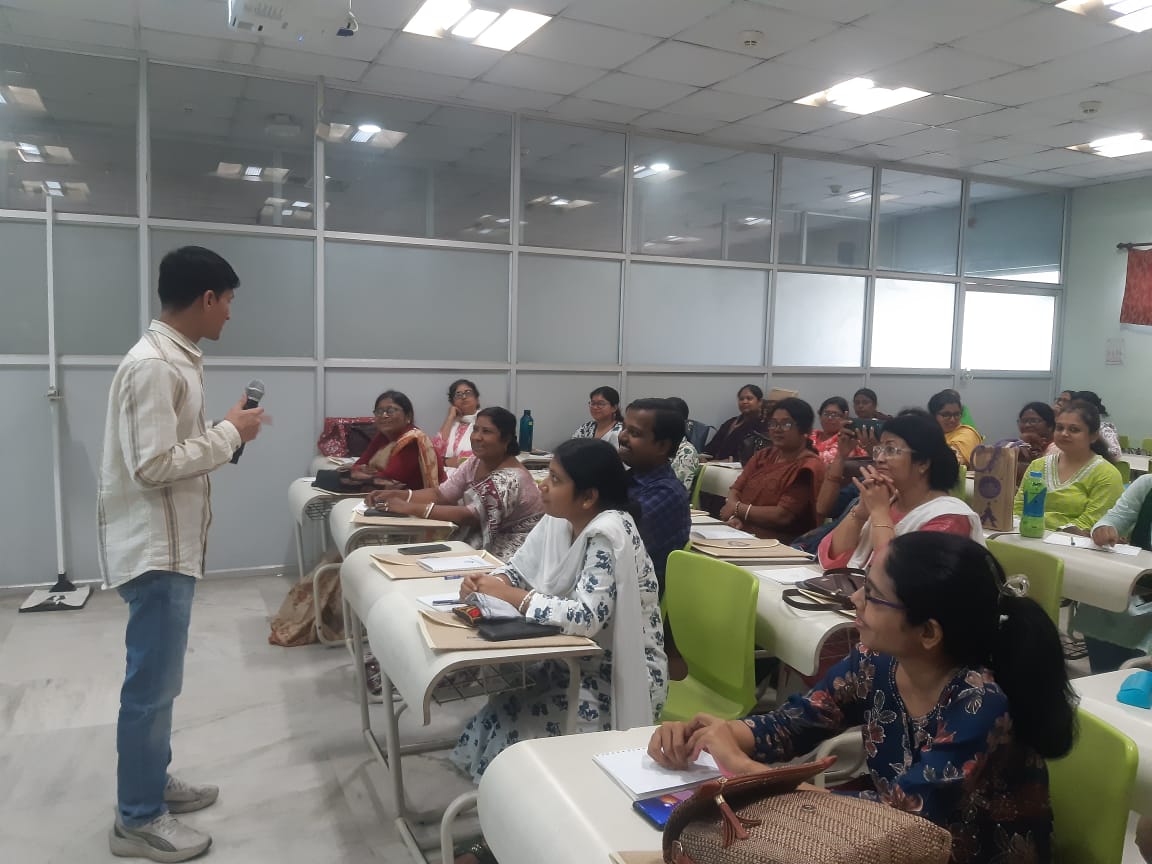– By Vasudha Arabandi, National Initiatives and Communications Associate
As we celebrate the International Day of Play, we turn the spotlight on educators who are championing the power of play in early childhood care and education. In this special edition of Drivers of ECCE series, we speak with Mr. Nishant Gahoi, an ECCE trainer, who has been instrumental in delivering Poshan Bhi Padhai Bhi training to Child Development Project Officer (CDPO), Anganwadi supervisors and Anganwadi workers.
Drawing from his experience conducting both online and offline sessions, Nishant shares how a play-based approach—rooted in the five developmental domains outlined in the National Education Policy—is transforming classroom practice and enriching the learning journey of millions of children. From building the capacity of Anganwadi workers to advocating for holistic development, he reflects on how play isn’t just fun—it’s foundational.


Q: Tell us about your role at Rocket Learning?
Nishant: I am a consultant at Rocket Learning and work as an ECCE trainer for Poshan Bhi Padhai Bhi training, in coordination with NIPCCD regional centres, conducting both online and offline sessions. Since I joined Rocket Learning, via NIPCCD I got the chance to work on ECD through a play-based approach. The focus is on the holistic development of children, taking into account all five domains of development as outlined in the National Education Policy. The aim is to explore how play-based learning can be used to support children pedagogically, ensuring their overall development.
Q: What has been one of your most profound experiences from training?
Nishant: There is a resounding consensus that before this, we never had a concrete discussion on ECCE ideas. For example, when it comes to ideas like ‘school readiness’, there is a common perception that we have to teach children to memorise alphabets and numbers in the early years. But actually, we have just found out that this is not part of school readiness. We actually have to teach children about phonetics and sound awareness. We don’t have to teach numbers directly, but rather teach counting through objects. We have to build concepts for children at this level! There is a probability that the scenario can change through PBPB!
Q: How do you see learning as play?
Nishant: I feel that we often restrict children too much and also underestimate them. We were working on designing a curriculum for the state of Madhya Pradesh, post-NEP implementation. The curriculum was theme-based, and after its implementation, we engaged both with the children and the workers to understand the experience.
During one such visit, an Anganwadi worker pointed to a child and said, “Sir, this child jyst plays throughout the day and keeps looking out of the window. He won’t learn anything.” We decided to talk to the child. And what we found was fascinating.
The child said, “Sir, do you know how many vehicles go there?” He went on to explain that there’s a petrol pump nearby where a huge tanker comes, fills petrol into the underground tank, and then petrol is filled into cars using machines all day. He told us about the several types of vehicles in great detail. This made the Anganwadi worker realise that her perception of the child was limited. While she thought the child was just idly playing, in reality, he was extremely observant. Play was giving him real-life exposure to understand the world around him in a very concrete way.
There was another instance involving a two-and-a-half-year-old girl who used to come to the Anganwadi with her older brother. This girl would usually stay quiet, and would never participate in any activities. But one day, when we asked her if she knew any poems or stories, she suddenly recited:
“Papa ka paisa gol gol, Mummy ki roti gol gol.”
The Anganwadi worker was surprised to see that the quiet child, who never spoke during sessions, actually remembered several poems and stories. These experiences show how much children absorb and learn through play and observation, even when it isn’t immediately visible. Play provides them with a rich, concrete learning environment that we don’t notice.
Q: How do you communicate the importance of play-based learning to Anganwadi workers during your training sessions?
Nishant: I give a lot of examples in my training almost in every session. One of my favourite ones is about my niece.
When she was around two years old, she was very naughty, full of energy and always up to something. Around the time of my brother’s wedding, we had a lot of wedding cards lying around. We were writing guest names on them to send out invitations, and she also joined in. Of course, she was just scribbling, but this was the beginning of her pre-writing skills. She was learning. I think she was about two and a half at that time. I often share this example when we talk about different domains of development, especially cognitive and language development. We might think the child is being mischievous, but this scribbling is actually the child’s way of learning and expressing.
So, when we think children are just playing or not learning anything, we’re often wrong. Children observe deeply. A print-rich environment whether at home or school, provides them with opportunities to engage and learn naturally. If we want to encourage self-learning, adopting a play-based approach is essential. Through play, we can instill a strong foundation for language, literacy, and cognitive development in children without them even realising they’re “learning.”
Q: What has been the initial response of CDPOs/Supervisors to the play-based approach? Are they open to it?
Nishant: My approach has always been the same. I focus on giving real, convincing examples, which are relatable and grounded in everyday life. I also make it a point to remind them that the generation we grew up in is very different from the one we’re working with today.
The pedagogical approaches used 30 years ago or even 20 years ago when I was studying don’t always apply today. For example, earlier, to instill values in children, we were told stories like that of Shravan Kumar, who took his blind parents on a pilgrimage. While that might have worked in the past, today’s children learn differently. They observe values through behaviour, not just stories. So, if we want to teach values, we need to live with them consistently. Children will pick up on what they see more than what they’re told.
These are the kind of examples I like to share. Of course, not everyone agrees—there are differences of opinion. Some participants resonate with what I say, and some don’t. But my effort is always to make them reflect realistically. I try to establish that if we want to remain effective educators, we need to adapt our pedagogical tools and methods to suit this generation. Sometimes, I’m able to convince the participants, and sometimes I’m not. But I believe that even if 10–20% of them are convinced, that’s still a success. Change happens slowly, but even a small shift in mindset is a step forward.
Q: From your perspective, how successful has the PBPB initiative been so far in implementing play-based learning at the grassroots level?
Nishant: The immediate success that we’ve seen with PBPB is the scale at which we are training people in the Anganwadi network. In the context of PBPB we’ve made tremendous progress. I believe we’ve trained around 36,000 SLMTs across different states.
Currently, I’m stationed in Madhya Pradesh. During our recent round of training in March, we trained 95,000 Anganwadi workers in just two slots. From a resource point of view, everything was well-coordinated. This gave me a lot of confidence that training is truly percolating down to the grassroots level. Across different states, I’ve observed that SLMTs now have access to much better infrastructure and support.
Academically, Rocket Learning has been a huge support. We were able to deliver solid academic training, not just in Madhya Pradesh but across all states. Of course, training on such a large scale is never easy but when we look at it practically, we’ve been able to deliver well-organised, timely sessions.
So, based on this experience, I feel confident that we will be able to train effectively at the tier-2 level as well. I’ve personally conducted sessions in West Bengal and Odisha, and I regularly see updates and photos on their WhatsApp groups. These give me a lot of insight and assurance that the quality of training at both tier-1 and tier-2 levels is strong.
Eventually, I believe we’ll start seeing the results of this effort in the field. It’s just a matter of time.
Q: Any final words? Or quotes you’d like to share with us?
Nishant: I didn’t expect I’d ever get to be part of a central government initiative. But I got the chance, and I can’t believe how fast the last eight months flew by. It’s been an incredibly insightful experience, especially handling large-scale training and engaging with multiple stakeholders. Honestly, it’s been a journey of real learning for me.